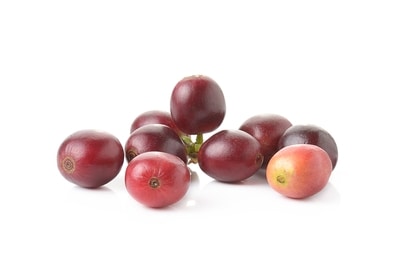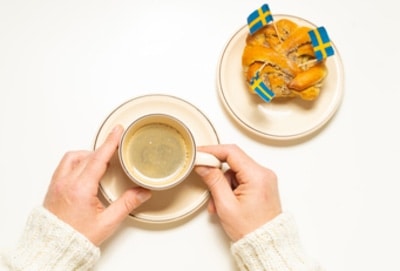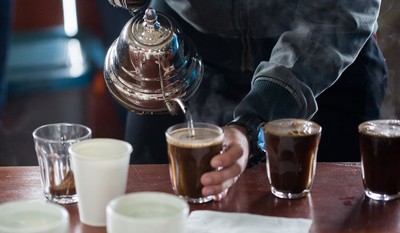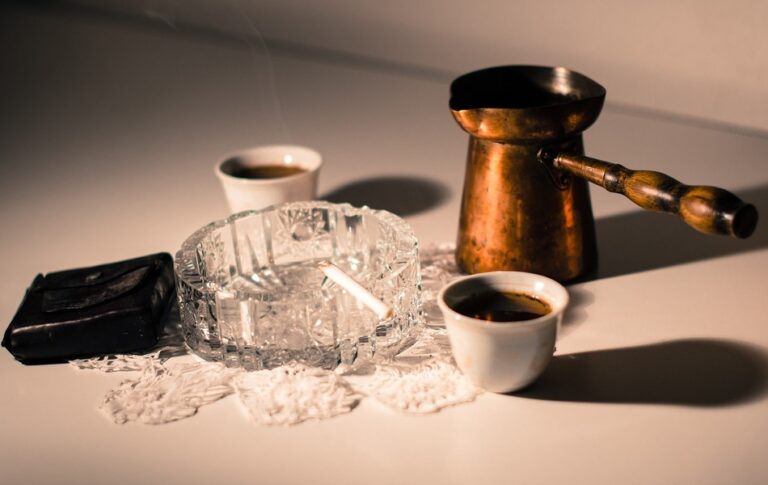What Is a Coffee Cherry? (The Fruit That Gives Us Coffee)
It’s a little known fact that your cup of coffee comes from a piece of fruit known as the coffee cherry. But what exactly is a coffee cherry?
The coffee cherry is the familiar name given to the fruit of the coffee plant. The coffee cherry is a type of drupe (stone fruit) that is usually red in colour when fully ripe. Inside each cherry fruit are two green seeds, which are the coffee beans used to make coffee.
So coffee beans are actually green seeds from a piece of fruit known as a coffee cherry. Has everyone gone mad?
The coffee cherry
The coffee cherry gets its name from its resemblance to normal cherries. Despite their similar appearance, they are not related to cherries except for the fact that they’re both stone fruits (drupes).
As with any plant, there are many varieties of coffee plant, each with its own characteristics.
Coffee cherries grow in clusters along the branches of the coffee plant. Each cherry measures about the size of a small grape.
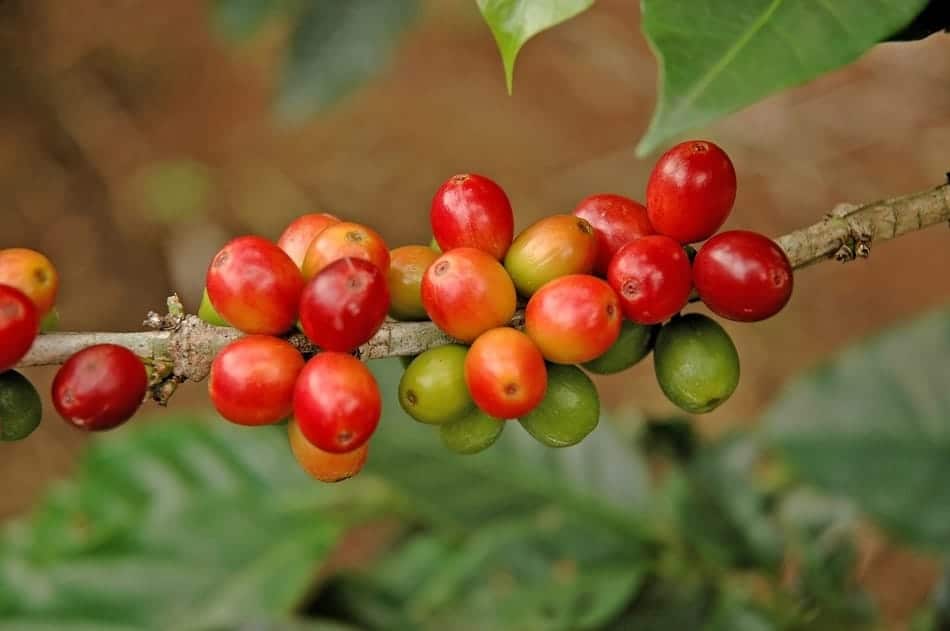
All unripe coffee cherries are green in colour and become either red, yellow or orange when ripe. The final colour is determined by the variety of coffee. The majority of coffee produced around the world is of the red-fruiting variety.
Red-fruiting cherries are preferred as they are more easily identifiable when fully ripe. The cherries start out green, turn to yellow and finally to red.
Identify the cherries
Being able to identify when the cherries are ripe is vitally important as the increase in sugar levels has an enormous impact on the quality of the coffee beans. Just as with any fruit, one that has had chance to ripen fully will always be superior in flavour, being sweeter and more balanced in flavour.
The anatomy of the coffee cherry is similar to other stone fruits such as plums, peaches, almonds and olives. All stone fruits are built up of several layers.
These layers can be divided into two main groups: the fruit pulp and the seed (bean). The outer group is called the pericarp and consists of three layers. The inner group which houses the seeds also consists of three layers.
Inside each cherry is usually two seeds, although around five percent of the time the cherry only contains one seed. When only one round seed is formed, it’s known as a peaberry.
Raw coffee beans are actually green in colour and only turn into their familiar brown once they are roasted.
Coffee cherries are edible
Beneath the skin of the coffee cherry is a layer of fruit that is edible to humans. The fruit has a pleasing sweetness and refreshing acidity. However, coffee cherries contain very little edible fruit as the beans occupy most of the space.
Sometimes the fresh cherries are squeezed to make a drink, but it’s not commonly practised as juicing is difficult given how little fruit there is surrounding the beans.
The fruit tastes nothing like roasted coffee beans. This is not surprising as the raw, green beans inside the cherries do not display any of the flavour and aroma characteristics that we associate with coffee because they have yet to be roasted.
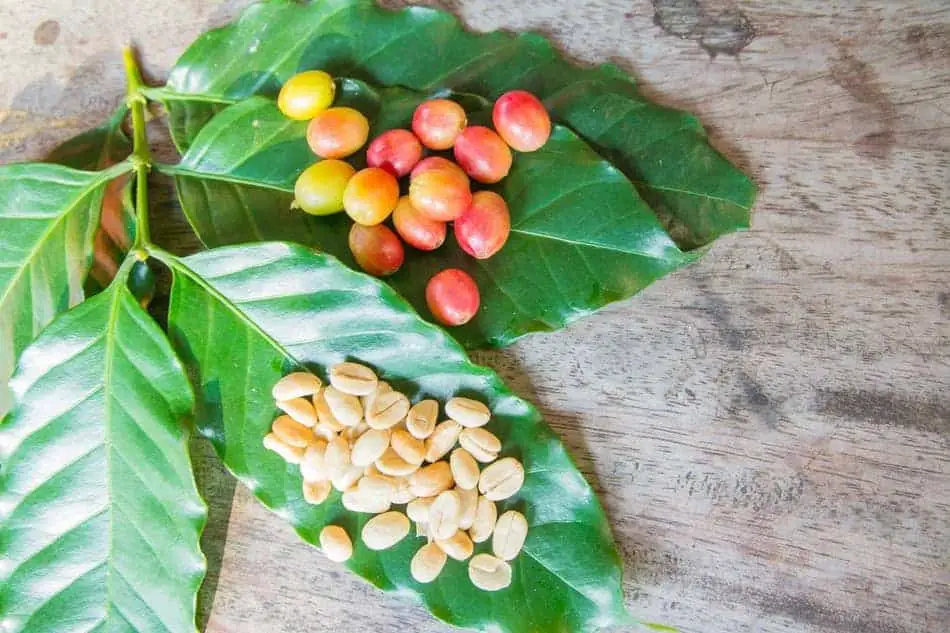
Once the coffee cherries have been picked, those that are to undergo the washed process are sent to a depulping station. A depulper is a mechanical device that separates the fruit flesh from the beans.
The majority of the cherry skins are discarded after they have been removed, but some farmers choose to dry the skins in order to make a product known in English as cascara. The dried cascara skins can be combined with water to produce a deliciously fruity beverage.
The drink is often referred to as coffee cherry tea; however, a more accurate description is a fruit tisane.
As the coffee plant naturally produces caffeine as a pesticide to protect itself, some of this caffeine is stored within the coffee cherry, so cascara definitely provides a caffeine-boost.
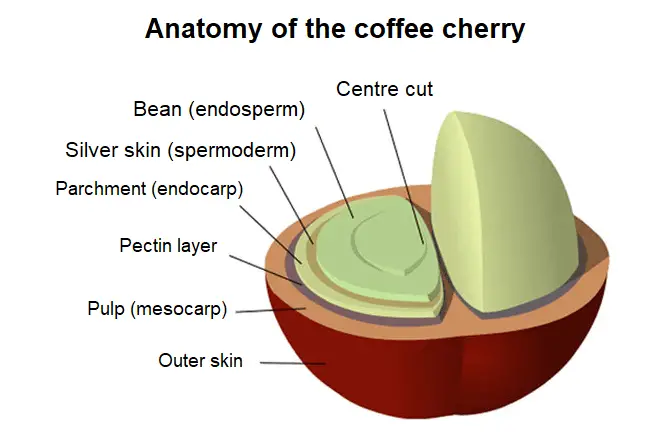
Anatomy of the coffee cherry
The first three layers that make up the coffee cherry fruit is known as the pericarp. The first and outermost layer of the pericarp is the exocarp (skin).[1]
Below the skin is the mesocarp (mucilage), which is a thin layer of pulp. The pulp is the sweet, edible flesh of the cherry.
Beneath the mesocarp and surrounding the coffee seeds (beans) is a sticky, honey-like layer called the parenchyma. This third layer of the pericarp protects the beans and is primarily made up of cellulose with small amounts of pectin.[2]
Beneath the parenchyma is the final layer of the pericarp. The beans are contained inside a paper-like envelope called the endocarp, more commonly referred to as parchment.
Housed inside the pericarp is the second group: the seed (bean). The seeds are coated in a very thin membrane that protects the seed. This membrane, or testa, is called the spermoderm but is commonly known in the coffee industry as the silver skin.
Within the seeds themselves are the endosperm and embryo. The endosperm is a living tissue that surrounds the embryo. It contains a hard external region and soft internal region.
Inside the endosperm is the embryo, which measures just 3 – 4mm. The embryo is responsible for the germination of the coffee seeds.
Cascara: the drink made from coffee skins
Cascara is the name given to both the coffee cherry skin once it has been removed from the seeds and undergone drying and also to the resulting drink that’s created using the dried skins.
Once dried, the skins resemble husks. These husks can be infused in water, imparting their flavour to create a fruity infusion.
The drink is usually brewed with hot water but can also be prepared using cold water, too. The word cascara comes from the Spanish (cáscara) meaning husk, skin or peel.
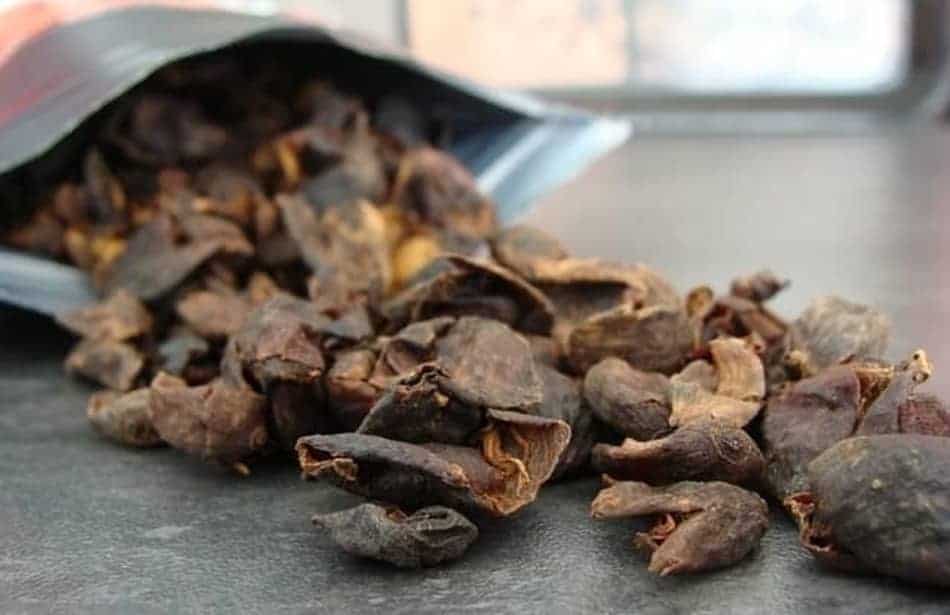
Coffee farmers have to decide whether to process their coffee with or without water, and these processes are known as the washed, natural or honey process.
Whichever processing method the farmer decides, at some point the outer skin of the coffee cherry has to be removed in order to reveal the green coffee beans housed inside.
Drying the coffee skins in order to become cascara can be as labour intensive and risky as drying coffee beans, and the fact there isn’t much of a demand for cascara means that most farms discard the skins or use them as fertiliser for the farm.
Cascara is commonly referred to as a tea, and there’s no doubt that it’s closer in flavour to what we think of as herbal tea. However, cascara is not of the Camellia sinensis plant from which tea is derived and so cannot accurately be described as tea.
Cascara cherries
Despite the fact the cherries are from the coffee plant, it cannot be considered coffee either as coffee is made using roasted coffee beans. Therefore, the best descriptor for cascara is a fruit tisane.
A well-processed cascara has natural flavour characteristics like that of good-quality coffees. The flavours are varied and range from berries and currants to floral and even smoky, tobacco notes.
As with coffee beans, the coffee variety, growing conditions, geographical location and even the weather each affect how the cascara will taste.
Cascara is usually prepared by combining the cascara husks with boiling water at a ratio of around 5g cascara per 100ml water. The drink can also be made using cold water too, creating a refreshing summer’s drink just like with cold brew coffee.
The cascara is left to steep for around four minutes and then the cascara is filtered or strained. A great way to make cascara is using a French press as the metal filter does a perfect job of filtering the large cascara husks.

There is a misconception that cascara contains a higher level of caffeine than the coffee beans; however, recent findings have shown that cascara only contains around 10 – 25 percent of the levels of caffeine found in the beans.
Cascara recently disappeared in the UK and Europe due to the sale of cascara not having any strict regulations. Two big names in the coffee industry, James Hoffmann and Klaus Thomsen, are working to get cascara back on sale, but the jury’s out as to how long this will take.
In the meantime, those in the US, Canada, Australia and New Zealand can still enjoy cascara and its health benefits.
Cascara syrup
In recent years, there’s been a new trend for cascara syrup made popular by the coffee behemoth Starbucks.
Cascara syrup is prepared using a mix of brewed cascara tisane and sugar to create a thick syrup. The syrup can be a great accompaniment to drinks (such as with Starbucks Cascara Latte) or as a topping for sweet treats such as pancakes or waffles.
Cascara syrup is now available in the US to buy in bottles if you don’t fancy making it yourself. However, the fact that it’s not in demand means that a 750ml (25fl oz) bottle will set you back something like $25.
Final thoughts
Coffee cherries provide a unique drink that has long remained just a byproduct of the coffee-making process.
Around the world, unroasted green coffee beans are also being used for their supposed health benefits. But despite these new kids on the block, coffee remains king.
The amount of ways to create delicious coffee beverages is seemingly endless. Take a look at 38 delicious types of coffee drinks that you might be able to try on your next visit to your favourite cafe.

